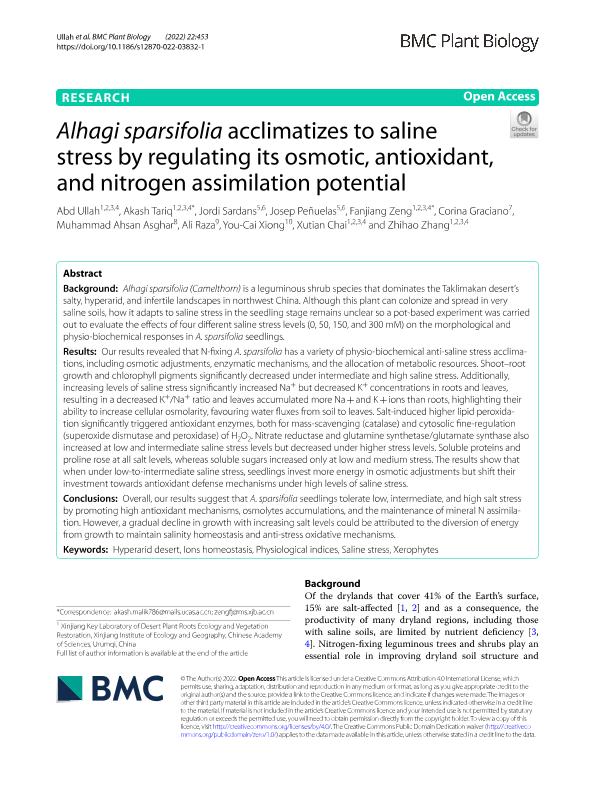Mostrar el registro sencillo del ítem
dc.contributor.author
Ullah, Abd
dc.contributor.author
Tariq, Akash
dc.contributor.author
Sardans, Jordi
dc.contributor.author
Peñuelas, Josep
dc.contributor.author
Zeng, Fanjiang
dc.contributor.author
Graciano, Corina

dc.contributor.author
Asghar, Muhammad Ahsan
dc.contributor.author
Raza, Ali
dc.contributor.author
Xiong, You Cai
dc.contributor.author
Chai, Xutian
dc.contributor.author
Zhang, Zhihao
dc.date.available
2023-09-26T09:55:22Z
dc.date.issued
2022-12
dc.identifier.citation
Ullah, Abd; Tariq, Akash; Sardans, Jordi; Peñuelas, Josep; Zeng, Fanjiang; et al.; Alhagi sparsifolia acclimatizes to saline stress by regulating its osmotic, antioxidant, and nitrogen assimilation potential; BioMed Central; BMC Plant Biology; 22; 1; 12-2022; 1-17
dc.identifier.issn
1471-2229
dc.identifier.uri
http://hdl.handle.net/11336/212998
dc.description.abstract
Background: Alhagi sparsifolia (Camelthorn) is a leguminous shrub species that dominates the Taklimakan desert’s salty, hyperarid, and infertile landscapes in northwest China. Although this plant can colonize and spread in very saline soils, how it adapts to saline stress in the seedling stage remains unclear so a pot-based experiment was carried out to evaluate the effects of four different saline stress levels (0, 50, 150, and 300 mM) on the morphological and physio-biochemical responses in A. sparsifolia seedlings. Results: Our results revealed that N-fixing A. sparsifolia has a variety of physio-biochemical anti-saline stress acclimations, including osmotic adjustments, enzymatic mechanisms, and the allocation of metabolic resources. Shoot–root growth and chlorophyll pigments significantly decreased under intermediate and high saline stress. Additionally, increasing levels of saline stress significantly increased Na+ but decreased K+ concentrations in roots and leaves, resulting in a decreased K+/Na+ ratio and leaves accumulated more Na + and K + ions than roots, highlighting their ability to increase cellular osmolarity, favouring water fluxes from soil to leaves. Salt-induced higher lipid peroxidation significantly triggered antioxidant enzymes, both for mass-scavenging (catalase) and cytosolic fine-regulation (superoxide dismutase and peroxidase) of H2O2. Nitrate reductase and glutamine synthetase/glutamate synthase also increased at low and intermediate saline stress levels but decreased under higher stress levels. Soluble proteins and proline rose at all salt levels, whereas soluble sugars increased only at low and medium stress. The results show that when under low-to-intermediate saline stress, seedlings invest more energy in osmotic adjustments but shift their investment towards antioxidant defense mechanisms under high levels of saline stress. Conclusions: Overall, our results suggest that A. sparsifolia seedlings tolerate low, intermediate, and high salt stress by promoting high antioxidant mechanisms, osmolytes accumulations, and the maintenance of mineral N assimilation. However, a gradual decline in growth with increasing salt levels could be attributed to the diversion of energy from growth to maintain salinity homeostasis and anti-stress oxidative mechanisms.
dc.format
application/pdf
dc.language.iso
eng
dc.publisher
BioMed Central

dc.rights
info:eu-repo/semantics/openAccess
dc.rights.uri
https://creativecommons.org/licenses/by/2.5/ar/
dc.subject
HYPERARID DESERT
dc.subject
IONS HOMEOSTASIS
dc.subject
PHYSIOLOGICAL INDICES
dc.subject
SALINE STRESS
dc.subject
XEROPHYTES
dc.subject.classification
Silvicultura

dc.subject.classification
Agricultura, Silvicultura y Pesca

dc.subject.classification
CIENCIAS AGRÍCOLAS

dc.title
Alhagi sparsifolia acclimatizes to saline stress by regulating its osmotic, antioxidant, and nitrogen assimilation potential
dc.type
info:eu-repo/semantics/article
dc.type
info:ar-repo/semantics/artículo
dc.type
info:eu-repo/semantics/publishedVersion
dc.date.updated
2023-07-07T21:36:30Z
dc.journal.volume
22
dc.journal.number
1
dc.journal.pagination
1-17
dc.journal.pais
Reino Unido

dc.journal.ciudad
Londres
dc.description.fil
Fil: Ullah, Abd. Chinese Academy of Sciences; República de China
dc.description.fil
Fil: Tariq, Akash. Consejo Superior de Investigaciones Científicas. Centre de Recerca Ecológica I Aplicacions Forestals; España
dc.description.fil
Fil: Sardans, Jordi. Consejo Superior de Investigaciones Científicas. Centre de Recerca Ecológica I Aplicacions Forestals; España
dc.description.fil
Fil: Peñuelas, Josep. Consejo Superior de Investigaciones Científicas. Centre de Recerca Ecológica I Aplicacions Forestals; España
dc.description.fil
Fil: Zeng, Fanjiang. Chinese Academy of Sciences; República de China
dc.description.fil
Fil: Graciano, Corina. Consejo Nacional de Investigaciones Científicas y Técnicas. Centro Científico Tecnológico Conicet - La Plata. Instituto de Fisiología Vegetal. Universidad Nacional de La Plata. Facultad de Ciencias Naturales y Museo. Instituto de Fisiología Vegetal; Argentina
dc.description.fil
Fil: Asghar, Muhammad Ahsan. No especifíca;
dc.description.fil
Fil: Raza, Ali. University of Chinese Academy of Sciences; China
dc.description.fil
Fil: Xiong, You Cai. Lanzhou University; China
dc.description.fil
Fil: Chai, Xutian. Chinese Academy of Sciences; República de China
dc.description.fil
Fil: Zhang, Zhihao. Chinese Academy of Sciences; República de China
dc.journal.title
BMC Plant Biology

dc.relation.alternativeid
info:eu-repo/semantics/altIdentifier/doi/http://dx.doi.org/10.1186/s12870-022-03832-1
Archivos asociados
